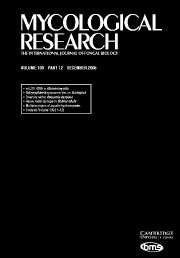Crossref Citations
This article has been cited by the following publications. This list is generated based on data provided by
Crossref.
Jacobs, K
Wingfield, M J
and
Wingfield, B D
2001.
Phylogenetic relationships in Leptographium based on morphological and molecular characters.
Canadian Journal of Botany,
Vol. 79,
Issue. 6,
p.
719.
Kirschner, Roland
2003.
Two new species of Pyxidiophora associated with bark beetles in Europe.
Mycological Progress,
Vol. 2,
Issue. 3,
p.
209.
Gibb, Ewan A.
and
Hausner, Georg
2003.
A group I intron-like sequence in the nuclear small ribosomal subunit gene of the ophiostomatoid fungus Gondwanamyces proteae.
Mycological Research,
Vol. 107,
Issue. 12,
p.
1442.
Hausner, Georg
and
Reid, James
2004.
The nuclear small subunit ribosomal genes of Sphaeronaemella helvellae, Sphaeronaemella fimicola, Gabarnaudia betae, and Cornuvesica falcata: phylogenetic implications.
Canadian Journal of Botany,
Vol. 82,
Issue. 6,
p.
752.
Roets, F.
Dreyer, L.L.
Crous, P.W.
and
Cowling, R.M.
2005.
Seasonal trends in colonisation of Protea infructescences by Gondwanamyces and Ophiostoma spp..
South African Journal of Botany,
Vol. 71,
Issue. 3-4,
p.
307.
Hibbett, David S.
Binder, Manfred
Bischoff, Joseph F.
Blackwell, Meredith
Cannon, Paul F.
Eriksson, Ove E.
Huhndorf, Sabine
James, Timothy
Kirk, Paul M.
Lücking, Robert
Thorsten Lumbsch, H.
Lutzoni, François
Matheny, P. Brandon
McLaughlin, David J.
Powell, Martha J.
Redhead, Scott
Schoch, Conrad L.
Spatafora, Joseph W.
Stalpers, Joost A.
Vilgalys, Rytas
Aime, M. Catherine
Aptroot, André
Bauer, Robert
Begerow, Dominik
Benny, Gerald L.
Castlebury, Lisa A.
Crous, Pedro W.
Dai, Yu-Cheng
Gams, Walter
Geiser, David M.
Griffith, Gareth W.
Gueidan, Cécile
Hawksworth, David L.
Hestmark, Geir
Hosaka, Kentaro
Humber, Richard A.
Hyde, Kevin D.
Ironside, Joseph E.
Kõljalg, Urmas
Kurtzman, Cletus P.
Larsson, Karl-Henrik
Lichtwardt, Robert
Longcore, Joyce
Miądlikowska, Jolanta
Miller, Andrew
Moncalvo, Jean-Marc
Mozley-Standridge, Sharon
Oberwinkler, Franz
Parmasto, Erast
Reeb, Valérie
Rogers, Jack D.
Roux, Claude
Ryvarden, Leif
Sampaio, José Paulo
Schüßler, Arthur
Sugiyama, Junta
Thorn, R. Greg
Tibell, Leif
Untereiner, Wendy A.
Walker, Christopher
Wang, Zheng
Weir, Alex
Weiss, Michael
White, Merlin M.
Winka, Katarina
Yao, Yi-Jian
and
Zhang, Ning
2007.
A higher-level phylogenetic classification of the Fungi.
Mycological Research,
Vol. 111,
Issue. 5,
p.
509.
Roets, F.
Wingfield, M.J.
Crous, P.W.
and
Dreyer, L.L.
2009.
Fungal radiation in the Cape Floristic Region: An analysis based on Gondwanamyces and Ophiostoma.
Molecular Phylogenetics and Evolution,
Vol. 51,
Issue. 1,
p.
111.
Madrid, H.
Gené, J.
Cano, J.
Silvera, C.
and
Guarro, J.
2010.
Sporothrix brunneoviolaceaandSporothrix dimorphospora, two new members of theOphiostoma stenoceras-Sporothrix schenckiicomplex.
Mycologia,
Vol. 102,
Issue. 5,
p.
1193.
Réblová, M.
Gams, W.
and
Seifert, K.A.
2011.
Monilochaetes and allied genera of the Glomerellales, and a reconsideration of families in the Microascales.
Studies in Mycology,
Vol. 68,
Issue. ,
p.
163.
Réblová, Martina
and
Réblová, Kamila
2013.
RNA secondary structure, an important bioinformatics tool to enhance multiple sequence alignment: a case study (Sordariomycetes, Fungi).
Mycological Progress,
Vol. 12,
Issue. 2,
p.
305.
Aylward, Janneke
Dreyer, Léanne L.
Steenkamp, Emma T.
Wingfield, Michael J.
and
Roets, Francois
2014.
Development of polymorphic microsatellite markers for the genetic characterisation of Knoxdaviesia proteae (Ascomycota: Microascales) using ISSR-PCR and pyrosequencing.
Mycological Progress,
Vol. 13,
Issue. 2,
p.
439.
Aylward, Janneke
Dreyer, Léanne L.
Steenkamp, Emma T.
Wingfield, Michael J.
and
Roets, Francois
2015.
Long-distance dispersal and recolonization of a fire-destroyed niche by a mite-associated fungus.
Fungal Biology,
Vol. 119,
Issue. 4,
p.
245.
Aylward, Janneke
Dreyer, Léanne L.
Steenkamp, Emma T.
Wingfield, Michael J.
and
Roets, Francois
2015.
Knoxdaviesia proteae is not the only Knoxdaviesia-symbiont of Protea repens.
IMA Fungus,
Vol. 6,
Issue. 2,
p.
471.
Human, Zander R.
Moon, Kyuho
Bae, Munhyung
de Beer, Z. Wilhelm
Cha, Sangwon
Wingfield, Michael J.
Slippers, Bernard
Oh, Dong-Chan
and
Venter, Stephanus N.
2016.
Antifungal Streptomyces spp. Associated with the Infructescences of Protea spp. in South Africa.
Frontiers in Microbiology,
Vol. 7,
Issue. ,
Aylward, Janneke
Steenkamp, Emma T.
Dreyer, Léanne L.
Roets, Francois
Wingfield, Brenda D.
and
Wingfield, Michael J.
2016.
Genome sequences of Knoxdaviesia capensis and K. proteae (Fungi: Ascomycota) from Protea trees in South Africa.
Standards in Genomic Sciences,
Vol. 11,
Issue. 1,
Guevara-Suarez, Marcela
Llaurado, Marta
Pujol, Isabel
Mayayo, Emilio
Martin-Vicente, Adela
and
Gené, Josepa
2018.
Fungal Olecranon Bursitis in an Immunocompetent Patient by Knoxdaviesia dimorphospora sp. nov.: Case Report and Review.
Mycopathologia,
Vol. 183,
Issue. 2,
p.
407.
Aylward, Janneke
Wingfield, Brenda D.
Dreyer, Léanne L.
Roets, Francois
Wingfield, Michael J.
and
Steenkamp, Emma T.
2018.
Genomic overview of closely related fungi with different Protea host ranges.
Fungal Biology,
Vol. 122,
Issue. 12,
p.
1201.
Human, Zander R
Roets, Francois
Crous, Casparus J
Wingfield, Michael J
de Beer, Z Wilhelm
and
Venter, Stephanus N
2021.
Fire impacts bacterial composition in Protea repens (Proteaceae) infructescences.
FEMS Microbiology Letters,
Vol. 368,
Issue. 19,
Inácio, Maria L.
Marcelino, José
Lima, Arlindo
Sousa, Edmundo
and
Nóbrega, Filomena
2022.
Ceratocystiopsis quercina sp. nov. Associated with Platypus cylindrus on Declining Quercus suber in Portugal.
Biology,
Vol. 11,
Issue. 5,
p.
750.
Aylward, Janneke
Roets, Francois
Dreyer, Léanne L.
and
Wingfield, Michael J.
2023.
Unseen fungal biodiversity and complex inter-organismal interactions in Protea flower heads.
Fungal Biology Reviews,
Vol. 45,
Issue. ,
p.
100317.

